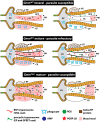Trypanosome infection establishment in the tsetse fly gut is influenced by microbiome-regulated host immune barriers
- PMID: 23637607
- PMCID: PMC3630092
- DOI: 10.1371/journal.ppat.1003318
Trypanosome infection establishment in the tsetse fly gut is influenced by microbiome-regulated host immune barriers
Abstract
Tsetse flies (Glossina spp.) vector pathogenic African trypanosomes, which cause sleeping sickness in humans and nagana in domesticated animals. Additionally, tsetse harbors 3 maternally transmitted endosymbiotic bacteria that modulate their host's physiology. Tsetse is highly resistant to infection with trypanosomes, and this phenotype depends on multiple physiological factors at the time of challenge. These factors include host age, density of maternally-derived trypanolytic effector molecules present in the gut, and symbiont status during development. In this study, we investigated the molecular mechanisms that result in tsetse's resistance to trypanosomes. We found that following parasite challenge, young susceptible tsetse present a highly attenuated immune response. In contrast, mature refractory flies express higher levels of genes associated with humoral (attacin and pgrp-lb) and epithelial (inducible nitric oxide synthase and dual oxidase) immunity. Additionally, we discovered that tsetse must harbor its endogenous microbiome during intrauterine larval development in order to present a parasite refractory phenotype during adulthood. Interestingly, mature aposymbiotic flies (Gmm(Apo)) present a strong immune response earlier in the infection process than do WT flies that harbor symbiotic bacteria throughout their entire lifecycle. However, this early response fails to confer significant resistance to trypanosomes. Gmm(Apo) adults present a structurally compromised peritrophic matrix (PM), which lines the fly midgut and serves as a physical barrier that separates luminal contents from immune responsive epithelial cells. We propose that the early immune response we observe in Gmm(Apo) flies following parasite challenge results from the premature exposure of gut epithelia to parasite-derived immunogens in the absence of a robust PM. Thus, tsetse's PM appears to regulate the timing of host immune induction following parasite challenge. Our results document a novel finding, which is the existence of a positive correlation between tsetse's larval microbiome and the integrity of the emerging adult PM gut immune barrier.
Conflict of interest statement
The authors have declared that no competing interests exist.
Figures





References
-
- Aksoy S, Gibson WC, Lehane MJ (2003) Interactions between tsetse and trypanosomes with implications for the control of trypanosomiasis. Adv Parasitol 53: 1–83. - PubMed
-
- Rio RV, Hu Y, Aksoy S (2004) Strategies of the home team: symbioses exploited for vector-borne disease control. Trends Microbiol 12: 325–336. - PubMed
Publication types
MeSH terms
Substances
Grants and funding
LinkOut - more resources
Full Text Sources
Other Literature Sources
Miscellaneous

